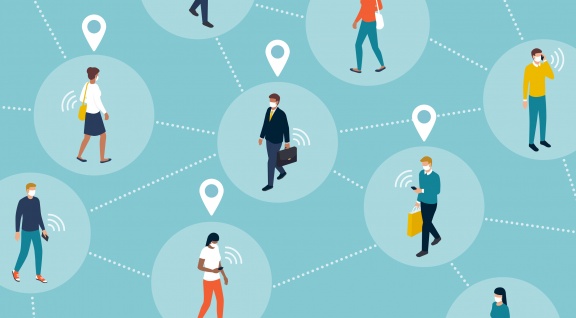The pandemic might have been many people’s first introduction to contact tracing, but the control measure has been used by health departments for decades to help stop the transmission of communicable diseases such as tuberculosis, SARS, Ebola and, now, COVID-19. According to the Centers for Disease Control and Prevention, contact tracing identifies those who have been exposed to a disease and ensures they do not interact with others, helping protect communities from further spread. These plans keep outbreaks from overwhelming the healthcare system and give scientists time to deliver targeted treatments and vaccines.
Knowing how crucial it would be to institute a COVID-19 contract tracing plan for its faculty and staff, Vanderbilt University Medical Center (VUMC)’s Occupational Health Clinic (OHC) got to work immediately to develop a robust monitoring system to identify VUMC employees who have been in close contact with COVID-19-positive patients, coworkers, family members or roommates. (Within 6 feet of a COVID-19 carrier for more than 10 minutes is considered close contact.)
“The reason we’re here is to protect our employees as they’re doing their job to protect everybody else,” said OHC Director Lori Rolando, MD, MPH.
The system allows the OHC team to efficiently investigate a person’s close contacts, determine the risk of exposure, and quickly communicate recommendations to those who have been exposed to a confirmed case of COVID-19. “Our goal is to inform our employees of known exposures and closely monitor each individual via daily symptom surveys to ensure any signs of infection are addressed early,” said Michael Chin, MD, MPH, Associate Director of the OHC.
Anyone who has tested positive for COVID-19 at any site across the VUMC network automatically goes into a COVID registry the moment the test result comes back, according to the VUMC Reporter.
“We reach out by email to all employees whose work would have put them in close contact with these patients,” said Clinic Instructor Tanicia Washington Haynes, NP, who leads clinic staff and around 30 trained volunteers in the monitoring effort. “We also conduct phone interviews with any employees who have tested positive themselves, and if it turns out they were at work during their infectious period, we ask about any close contact with co-workers during that time,” she said.
The program requires self-monitoring, which involves checking one’s temperature twice a day and completing a short daily email survey regarding symptoms.
5 Steps You Can Take
Contact tracing is typically a task undertaken by public health departments and larger employers, but it’s still important to be a good corporate partner and prop up efforts to curtail a disease’s spread. Here are some guidelines for supporting employees who have been exposed to COVID-19 and expediting effective contact tracing for your community:
1. Act quickly to arrest the spread. Educate employees on the symptoms of COVID-19 and make it part of companywide policy that they alert the HR team immediately if they’re diagnosed with the virus. The HR team should collaborate with their local health department to notify any co-workers who might have been exposed to this employee.
2. Acknowledge employees’ worries and questions. Develop a single source of truth—whether that’s an HR team member, a health department liaison or a clinical partner—who can answer employees’ questions. Assure exposed employees they will not lose their job or benefits during their time of quarantine and support them with helpful information such as isolation guidelines, recommendations for employees who have been tested and are awaiting test results, and a COVID-19 Patient Education Directory geared toward children, teens and families.
3. Assess whether the exposed employee is able to isolate and practice adequate infection control. It’s important for the person exposed to COVID-19 to be able to maintain social distance from others in a safe environment with access to a private room and bathroom, adequate food and water, and proper medication. In some cases, your employee might need housing assistance if their current living situation doesn’t allow them to separate themselves from others.
4. Make privacy a priority. Only disclose the minimum amount of information required to warn others of the risk of exposure while ensuring an employee’s medical record remains private. The Society for Human Resource Management advises employers that they “have the right to ask employees if they have symptoms or have been diagnosed with COVID-19 without violating the Americans with Disabilities Act, according to guidance from the Equal Employment Opportunity Commission. But they should never divulge the name of an infected employee to others at the workplace beyond those conducting the investigation.”
5. Consider technology tools. Hundreds of electronic monitoring apps have been developed to help public health agencies in their contact tracing efforts, and even Google and Apple are partnering to add a contract tracing option to their phones. Your employees might be interested in opting into these kinds of apps, which alert users through Bluetooth technology if they have come into contact with someone who has COVID-19.
